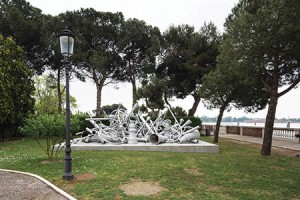Aramayis Orkusyan
Editor

Tadeh Issakhanian, Neery Melkonian, Lucie Ekezyan, and
Aramayis Orkusyan.
Photo: Barlow Der Mugrdechian
“2015 was a year of groundbreaking curatorial undertakings of Armenian art and marked a paradigm shift in the way contemporary Armenian art is conceptualized and exhibited globally,” stated Neery Melkonian, a New York-based independent researcher, writer, curator, and lecturer in modern and contemporary art. She discussed these shifts in her lecture, titled “What Comes After Undoing Denial: Reflections on Contemporary Art and Exhibition Practices in the Armenian Diaspora” on Friday, November 18.
Melkonian’s lecture was the concluding lecture in the Armenian Studies Program Fall 2015 Lecture Series, and was supported by the Leon S. Peters Foundation.
The first of the exhibits discussed by Melkonian was Life:100, displayed in the Brand Library of Los Angeles. Highlighting the importance of this exhibit, Melkonian stated, “For the first time, we were able to see, under the same roof, the works of masters like Gorky, Parajanov, Garabedian, Saroyan, Saryan, Avetisyan, etc. exhibited with younger living artists that are based in Los Angeles.”
The combination of modern and master artists allowed Life:100 to achieve its mission “to display the inspiring resilience, strength, creativity, and celebrate the contribution of artists of Armenian descent in re-establishing cultural identity and building creative spirit for the future.”
Re-establishing cultural iden-tity through art was also a key feature of Armenity (Հայություն) the Armenian National Pavilion of the 56th Venice Biennial curated by Swiss-Armenian Adeline Cüberyan von Fürstenberg. Armenity was exhibited on the Mekhitarist Monastery island of San Lazzaro and won the 2015 Golden Lion Award for best pavilion. Making use of every square inch of the monastic complex, Armenity was intended as a space to created dialogue about the Armenian Genocide. The pavilion was groundbreaking, however, because it achieved this atmosphere without the use of works that depicted crisis or massacre.
“One of the things that changed is that no longer was art displayed where you feel hopelessness or powerlessness, anger or victimhood,” explained Melkonian. Instead, Armenity concentrated on rediscovering “Armenianness” and recharac-terizing Armenian culture through works by Armenian artists of the diaspora.
The past year has also been groundbreaking for Armenia in the international art community in another respect. For the first time in 2015, the Turkish National Pavilion at the Venice Biennial was represented by Sarkis Zabunyan, known as Sarkis, a Turkish-Armenian artist.
Even more notably, 2015 saw the first time that Turkish artists addressed the Armenian Genocide at the 14th Turkish Biennial. Art has been able to transcend the “Taboo” of the Genocide in Turkey, and has become a medium creating dialogue about the events of 1915, where it previously was not allowed.
The last curatorial project discussed by Melkonian was Blind Dates, an ongoing project that is co-curated by Melkonian herself. Inspired by their “blind date,” Melkonian and Turkish co-curator Defne Ayas believed that “mediating similar encounters might encourage others to start undoing the complex knots that keep suspending ‘dialogue’ between estranged neighbors and distanced cultures.”
The project is a platform that brings together both artists and non-artists of Armenian and Turkish descent to work on a research based collaboration that aims to understand the rupture of the Ottoman Empire.
Behind all the changes that have taken place, however, there is an even more important mechanism at work. “None of this would have been possible if we didn’t see a shift in art patronage,” stated Melkonian.
“Armenians started spending money on contemporary and modern art. They are recognizing the soft power of art—that art may help change minds and help convince powers that may be. That’s what changed this year.”

Photo: Courtesy of Armenity
These changes were also evident in Fresno this year with the construction of the Armenian Genocide Monument on the Fresno State campus.
The goal of the Monument is to commemorate, educate, and inspire.
More than 20,000 students, faculty, and staff pass by the Monument daily.
The Monument transforms the catastrophe of the Armenian Genocide into an esthetic space where healing can take place.
The spirit of the Monument mirrors the changes taking place in the art world.
 Hye Sharzhoom Armenian Action
Hye Sharzhoom Armenian Action